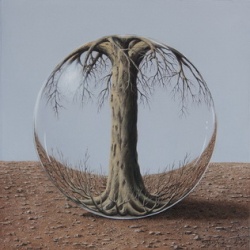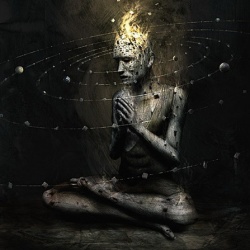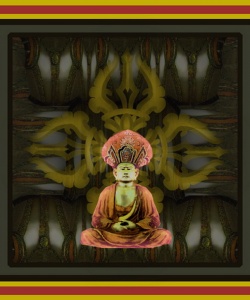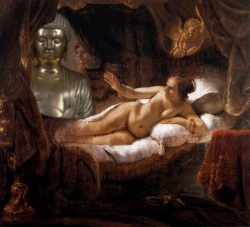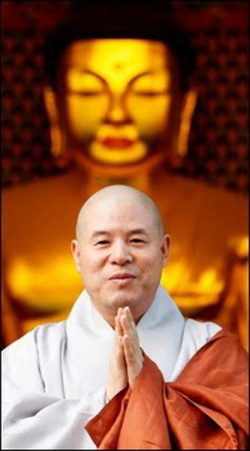Manual of Pramana - Reading Two: An Outline of All Existing Things
Selection from the collected topics:
An Outline of All Existing Things
The selection here is from the monastic textbook entitled An Explanation of the Science of Logic, included in the Advanced Path of Reasoning, a Section from the “Key to the Logic Machine,” a Presentation of the Collected Topics which Clarifies the Meaning of the Great Scriptures on Valid Perception (Tsad-ma’i gzhung-don ‘byed-pa’i bsdus-grva’i rnam-par bshad-pa rigs-lam ‘phrul gyi lde’u-mig las rigs-lam che-ba rtags-rigs kyi skor). The text was written by Purbuchok Jampa Tsultrim Gyatso (1825-1901), who in his day held the position of Tutor to the Dalai Lama.
Please note that indented statements are those made by the opponent. The logical statements in brackets are understood responses that are often left out of the text.
_______________
Here is the second section, an outline of existence. Here we will refute the position of our opponents, present our own position, and then finally disprove their rebuttal.
_______________
Here is the first. Suppose someone comes and makes the following claim: If a thing can be established as existing, then it is necessarily an unchanging thing.
Consider then a water pitcher.
So is it an unchanging thing?
Because it can be established as existing.
[It doesn't necessarily follow.]
But you already agreed that it does necessarily follow.
[It's not correct to say a water pitcher can be established as existing.]
Suppose you say that it’s not correct [to say that a water pitcher can be established as existing.]
It is so [something that can be established as existing),
Because it is established through a valid perception.
[It doesn't necessarily follow.]
It does necessarily follow,
Because “that which is established through a valid perception” is the definition of a thing which can be established as existing.
[Then I agree to your original statement: the water pitcher is an unchanging thing.]
Suppose you agree to our original statement, [that a water pitcher is an unchanging thing].
Consider the water pitcher.
It isn’t so, that it’s something unchanging;
Because it’s a thing that changes.
[It's not correct to say it's a thing that changes.]
Suppose you say that it’s not correct [to say that it's a thing that changes].
Consider this same thing.
It is so [something which changes],
Because it’s something that lasts only for a moment.
[It doesn't necessarily follow.]
It does necessarily follow,
Because “anything that lasts only for a moment” is the definition of a changing thing.
[It's not true that this is the definition of a changing thing.]
It is so the definition of a changing thing,
Because “anything that performs a function” is the definition of a working thing; “anything that stops” is the definition of a produced thing, and “anything that starts” is the definition of a made thing.
_______________
Suppose someone comes and makes the following claim:
If a thing is something which exists,
Then it must always be a working thing.
Consider empty space, the space which is unproduced.
So is it then [a working thing]?
Because it is [something which exists).
[It doesn't necessarily follow.]
But you already agreed that it does necessarily follow.
[It's not correct to say that it's something which exists.]
Suppose you say that it’s not correct [to say that it is something which exists).
Consider this same thing.
It is so [something which exists),
Because it can be established as existing through a valid perception.
[It doesn't necessarily follow.]
It does so [necessarily follow,]
Because “anything which can be perceived through a valid perception” is the definition of an existing thing.
[Then I agree to your original statement: empty space is a working thing.]
Suppose you agree to our original statement.
Consider this same thing.
Isn’t is so, that it is not a working thing?
Because it is a thing which has no work.
Suppose you say that it’s not correct [to say that it is a thing which has no work].
Consider this same thing.
It is so [a thing which has no work],
Because it is void of the quality of performing a function.
[It doesn't necessarily follow.]
It does necessarily follow,
Because “anything which is void of the quality of performing a function” is the definition of a thing which has no work; and “anything which never stops” is the definition of a thing which was not produced; and “anything which never starts” is the definition of a thing which was not made.
_______________
Suppose someone comes and makes the following claim:
Knowable things must always be knowable things which can be.
Consider the two of a pillar and a water pitcher.
So are they [a knowable thing which can be]?
Because they are [knowable things].
[It's not correct to say that they are knowable things.]
Suppose you say that it’s not correct [to say that they are knowable things].
They are so [knowable things],
Because they are things which exist.
[It doesn't necessarily follow.]
It does necessarily follow,
Because “knowable thing,” “something which exists,” “something which can be apprehended,” and “something which can be established as existing” are all different names for the same thing.
[Then I agree to your original statement: the two of a pillar and a water pitcher are a knowable thing which can be.]
Suppose you agree to our original statement.
Consider these same things.
It isn’t so, that they are a knowable thing which can be,
Because they are knowable things which cannot be.
[It's not correct to say that they are knowable things which cannot be.]
Suppose you say that it’s not correct [to say they are knowable things which cannot be].
Consider these same things.
They are so [knowable things which cannot be],
Because (1) they are knowable things and (2) there doesn’t exist a thing which is them.
The second point we just mentioned is easy to accept; now suppose you say that the first is not correct.
Consider these same things.
They are so [knowable things],
Because they are either one thing, or separate things, or both one thing and separate things.
[It's not correct to say that they are either one thing, or separate things, or both one thing and separate things.]
Suppose you say that it’s not correct [to say that they are either one thing, or separate things, or both one thing and separate things].
Consider these same things.
They are so [either one thing, or separate things, or both one thing and separate things,]
Because they are separate things.
[It's not correct to say that they are separate things.]
Suppose you say that it’s not correct [to say that they are separate things].
Consider these same things.
They are so [separate things],
Because they are separate in such a way that to be one always means that you cannot be the other.
[It's not correct to say that they are separate in a way that to be one always means that you cannot be the other.]
Suppose you say that it’s not correct [to say that they are separate in such a way that to be one always means that you cannot be the other].
It is so true, that the two of a pillar and a water pitcher are separate in such a way that to be one always means that you cannot be the other,
Because to be a pillar is not to be a water pitcher, and to be a water pitcher is not to be a pillar.
[It's not correct to say that to be a pillar is not to be a water pitcher.]
Suppose you say that it’s not correct to say the first, [that to be a pillar is not to be a water pitcher.]
Consider a pillar.
It is so true, that to be it is not to be a water pitcher,
Because (1) it exists and (2) it is not automatically a water pitcher.
_______________
Suppose someone comes and makes the following claim:
If something exists,
It must always be something which exists and which cannot be.
Consider a working thing.
So is it then something which exists and which cannot be?
Because it is [a thing which exists).
[It doesn't necessarily follow.]
But you already agreed that it does necessarily follow.
[It's not correct to say that a working thing is a thing which exists.]
Suppose you say that it’s not correct [to say that a working thing is a thing which exists).
Consider this same thing.
It is so [a thing which exists),
Because it’s either an unchanging thing, a working thing, or both;
Because it’s a working thing.
[Then I agree to your original statement: a working thing is something which exists and which cannot be.]
Suppose you agree to our original statement.
Consider this same thing.
It isn’t so, that it’s something which exists and which cannot be,
Because it’s something which exists and which can be.
[It's not correct to say that it's something which exists and which can be.]
Suppose you say that it’s not correct [to say that it's something which exists and which can be].
Consider this same thing.
It is so [something which exists and which can be],
Because (1) it is something which exists; and (2) the three of matter, mind, and those active things which are neither mind nor matter are all things which are different kinds of it.
[It's not correct to make the latter statement: that the three of matter, mind, and those active things which are neither mind nor matter are all things which are different kinds of working things.]
Suppose you say that it’s not correct to make the latter statement: [the statement that the three of matter, mind, and those active things which are neither mind nor matter are all things which are different kinds of working things].
Consider the three of matter, mind, and those active things which are neither mind nor matter.
They are so working things,
Because they are (1) things which exist and (2) are not things which are unchanging.
_______________
Suppose someone comes and makes the following claim:
If something is not a working thing, it must always be an unchanging thing.
Consider a rabbit’s horns.
So are they [an unchanging thing]?
Because they are [something which is not a working thing].
[It doesn't necessarily follow.]
But you already agreed that it does necessarily follow.
[It's not correct to say that a rabbit's horns are not a working thing.]
Suppose you say that it’s not correct [that a rabbit's horns are not a working thing.]
Consider this same thing.
They are so [not a working thing],
Because they are neither an unchanging thing, nor a working thing, nor both.
[It's not correct to say that they are neither an unchanging thing, nor a working thing, nor both.]
Suppose you say that it’s not correct [to say that they are neither an unchanging thing, nor a working thing, nor both].
Consider this same thing.
They are so [neither an unchanging thing, nor a working thing, nor both].
Because they are not something which exists.
[It's not correct to say that they are not something which exists.]
Suppose you say that it’s not correct [to say that they are not something which exists).
Consider this same thing.
They are so [not something which exists),
Because they are something which does not exist.
[It's not correct to say they are something which does not exist.]
Suppose you say that it’s not correct [to say that they are something which does not exist).
They are so [something which does not exist),
Because their existence cannot be established by a valid perception.
[Then I agree to your original statement: a rabbit's horns are an unchanging thing.]
Suppose you agree to our original statement, [that a rabbit's horns are an unchanging thing.]
Consider this same thing.
It’s not so, that they are an unchanging thing,
Because they are not something which exists.
[It's not correct to say that they are not something which exists.]
Suppose you say that it’s not correct [to say that they are not something which exists.]
Consider this same thing.
They are so [not something which exists),
Because they have no existing nature.
[It's not correct to say that a rabbit's horns have no existing nature.]
Suppose you say that it’s not correct [to say that a rabbit's horns have no existing nature).
Consider this same thing.
They are so [something that has no existing nature),
Because they are not something which holds any existing nature.
[It's not correct to say that a rabbit's horns are not something which holds any existing nature.]
Suppose you say that it’s not correct [to say that a rabbit's horns are not something which holds any existing nature).
Consider this same thing.
They are so [not something which holds any existing nature),
Because they are not a thing (a dharma).
[It doesn't necessarily follow.]
But it does necessarily follow, because “anything which holds an existing nature” is the definition of a “thing” (or dharma).
[This definition by the way reflects an etymological explanation in the Sanskrit, since the verbal root for "to hold" is dhO, which is also the root for dharma.]
______________
Suppose someone comes and makes the following claim:
If something is a thing, it can never be a thing which is such that there is a place where it doesn’t exist.
Consider a water pitcher.
So is it then [not a thing which is such that there is a place where it doesn't exist)?
Because it is [a thing].
[It doesn't necessarily follow.]
But you already agreed that it does necessarily follow.
[It's not correct to say that a water pitcher is a thing.]
Suppose you say that’s it’s not correct [to say that a water pitcher is a thing].
Consider this same thing.
It is so [a thing],
Because it is a thing which is produced.
[It's not correct to say that a water pitcher is a thing which is produced.]
Suppose you say that it’s not correct [to say that a water pitcher is a thing which is produced].
It is so [a thing which is produced],
Because it is a working thing.
[It's not correct to say that a water pitcher is a working thing.]
Suppose you say that it’s not correct [to say that a water pitcher is a working thing].
It is so [a working thing],
Because it is a thing which performs a function.
[It's not correct to say that a water pitcher is a thing which performs a function.]
Suppose you say that it’s not correct [to say that a water pitcher is a thing which performs a function).
It is so [a thing which performs a function),
Because it is an object with a rounded body and a supporting base which performs the function of holding water.
[It's not correct to say that a water pitcher is an object with a rounded body and a supporting base which performs the function of holding water.]
It is so [an object with a rounded body and a supporting base which performs the function of holding water),
Because it’s a water pitcher.
[It doesn't necessarily follow.]
But it does necessarily follow, because that is the classical definition of a water pitcher.
[Then I agree with your original statement: a water pitcher is not a thing which is such that there is a place where it doesn't exist.]
Suppose you agree with our original statement, [that a water pitcher is not a thing which is such that there is a place where it doesn't exist.]
It is so [a thing which is such that there is a place where it doesn't exist),
Because (1) there does exist a place where it doesn’t exist, and (2) it is a thing.
The second point we just mentioned is easy to accept; now suppose you say that the first is not correct.
It is so true [that there exists a place where a water pitcher doesn't exist),
Because there exists a location where there is no water pitcher.
[It's not correct to say that there is a location where there is no water pitcher.]
Suppose you say that it’s not correct [to say that there is a location where there is no water pitcher].
It is so true [that there is a location where there is no water pitcher],
Because if any particular thing is such that it has no self-nature, then it is not always the case that a water pitcher has to be there.
_______________
Someone may come and make the following claim:
If something is a thing which exists in and of itself, then it must always be mental.
Consider the two of matter and mind.
So are they then [something mental)?
Because they are [things which exist in and of themselves].
[It's not correct to say that the two of matter and mind are things which exist in and of themselves.]
Suppose you say that it’s not correct [to say that the two of matter and mind are things which exist in and of themselves].
Consider these same things.
They are so [things which exist in and of themselves],
Because they can be established as existing to the state of mind of direct, valid perception.
[It's not correct to say that the two of matter and mind can be established as existing to the state of mind of a direct, valid perception.]
Suppose you say that it’s not correct [to say that the two of matter and mind can be established as existing to the state of mind of a direct, valid perception.]
Consider these same things.
They can so [be established as existing to the state of mind of a direct, valid perception),
Because they are objects which present themselves to direct, valid perception.
[It's not correct to say that they are objects which present themselves to direct, valid perception.]
Suppose you say that it’s not correct [to say that they are objects which present themselves to direct, valid perception.]
They are so (objects which present themselves to direct, valid perception),
Because they are working things.
[It doesn't necessarily follow.]
But it does necessarily follow, because the terms “object which presents itself to direct, valid perception” and “working thing” are synonyms. And the terms “object which presents itself to conceptual thought” and “unchanging thing” are also synonyms.
[Then I agree with your original statement: the two of matter and mind are something mental.]
Suppose you agree with our original statement, [that the two of matter and mind are something mental.]
Consider these same things.
It’s not so, [that they are something mental),
Because they are active things which are neither mind nor matter.
[It doesn't necessarily follow.]
But it does necessarily follow, because these three—matter, mind, and active things which are neither mind nor matter—are always mutually exclusive.
_______________
Suppose someone comes and makes the following claim:
If something belongs to hidden reality, it must always be an idealization.
Consider a pitcher made of gold.
So is it then [an idealization]?
Because it is [something that belongs to hidden reality).
[It doesn't necessarily follow.]
But you already agreed that it does follow.
[It's not correct to say that a pitcher made of gold belongs to hidden reality.]
Suppose you say that it’s not correct [to say that a pitcher made of gold belongs to hidden reality).
Consider this same thing.
It is so [something which belongs to hidden reality),
Because it is something which can be perceived by a conceptual state of mind as something which is hidden.
[It doesn't necessarily follow.]
But it does necessarily follow,
Because that is the definition of what it is [to be something which belongs to hidden reality).
[Your point above is not correct: it's not correct to say that a pitcher made of gold is something which can be perceived by a conceptual state of mind as something which is hidden.]
Suppose you say that our point above is not correct; [that is, that it's not correct to say that a pitcher made of gold is something which can be perceived by a conceptual state of mind as something which is hidden].
Consider this same thing.
It is so something which can be perceived by a conceptual state of mind as something which is hidden,
Because it is something which can be apprehended by the particular conceptual state of mind which is grasping it.
[It's not correct to say that a vase made of gold is something which can be apprehended by the particular conceptual state of mind which is grasping it.]
Suppose you say that it’s not correct [to say that a vase made of gold is something which can be apprehended by the particular conceptual state of mind which is grasping it.]
Consider this same thing.
It is so [something which can be apprehended by the particular conceptual state of mind which is grasping it],
Because it is something which can be established as existing.
[Then I agree with your original statement: a pitcher made of gold is an idealization.]
Suppose you agree to our original statement, [that a pitcher made of gold is an idealization].
It isn’t so, [that it is an idealization],
Because it exists in and of itself.
[It's not correct to say that a pitcher made of gold exists in and of itself.]
Suppose say that it’s not correct [to say that a pitcher made of gold exists in and of itself.]
It does so (exist in and of itself],
Because it is a working thing.
[It doesn't necessarily follow.]
But it does necessarily follow, because “working thing,” “thing which exists in and of itself,” and “thing which is ultimately real” are all different names for the same thing. And “unchanging thing,” “idealization,” and “thing which is deceptively real” are also all different names for the same thing.
_______________
Suppose someone comes and makes the following claim:
If something belongs to obvious reality, then it can never belong to hidden reality.
Consider a pillar.
So is it then [something that could never belong to hidden reality)?
Because it is [something which belongs to obvious reality).
[It's not correct to say that a pillar is something which belongs to obvious reality.]
Suppose you say that it’s not correct [to say that a pillar is something which belongs to obvious reality).
Consider this same thing.
It is so [something which belongs to obvious reality),
Because it’s a thing which can be perceived directly by direct, valid perception.
[It doesn't necessarily follow.]
But it does necessarily follow, because “anything which can be perceived directly by direct, valid perception” is the definition of a thing which belongs to obvious reality.
[Your point above is not correct: it's not correct to say that a pillar is a thing which can be perceived directly by direct, valid perception.]
Suppose you say that our point above is not correct; [suppose you say that a pillar is not a thing which can be perceived directly by direct, valid perception).
Consider this same thing.
It is so [a thing which can be perceived directly by direct, valid perception),
Because it is a working thing.
[Then I agree with your original statement: a pillar is something that could never belong to hidden reality.]
Suppose you agree with our original statement.
Consider this same thing.
It is so something which can belong to hidden reality,
Because it is something which can be perceived by a conceptual state of mind as something which is hidden.
The reason has already been proven.
Here is the second major part, where we present our own position.
There does exist a definition for “that which can be established as existing,”
Because “that which can be established by a valid perception” is the definition.
There do exist two different categories for “that which can be established as existing,”
Because there exist the categories of “unchanging things” and “working things.”
There does exist a definition for “unchanging thing,”
Because “one object which is both a thing and which is not such that it only lasts for a moment” is the definition of an “unchanging thing.”
Things which are unchanging can be divided into two different types: unchanging things which can be, and unchanging things which cannot be.
There does exist something which is an unchanging thing that can be,
Because “knowable things” is it.
There does exist something which is an unchanging thing that cannot be,
Because “the two of unchanging things and changing things” is it.
There does exist a definition of “working thing,”
Because “anything which performs a function” is the definition.
There exist three different kinds of working things, for there are the three of matter, mind, and active things which are neither matter nor mind.
There does exist a definition for “matter,”
Because “something made of tiny physical particles” is the definition.
There are two different kinds of matter, for there are the two of outer physical matter and inner physical matter.
There does exist a definition for “outer physical matter,” for “something which is made of tiny physical particles, but which is not subsumed by the awareness of a being” is the definition.
There do exist classical examples of outer physical matter, for a water pitcher, a pillar, and the four elements of earth, water, fire, and wind are just such examples.
There does exist a definition for “inner physical matter,” for “something which is made of tiny physical particles, and which is subsumed by the awareness of a being” is the definition.
There does exist a classical example of inner physical matter, for the impure heap of physical formis just such an example.
There does exist a definition for “something mental,” because “anything which is both invisible and aware” is the definition.
There does exist a classical example of something mental, because visual consciousness is just such an example.
There does exist a definition for an “active thing which is neither matter nor mind,” because “any produced thing which is neither matter nor mind” is the definition.
There do exist classical examples of active things which are neither matter nor mind, because “working thing” and “changing thing” and persons such as horses or cattle are just such examples.
There does exist another way of dividing up those things which can be established as existing, because they can be divided into two, and these are the two of being either one thing or separate things.
There does exist a definition of “being one thing,” because “being a thing which is not individual things” is the definition.
There do exist classical examples of being one, because there are the examples of “all knowable things,” “all unchanging things,” and “all working things”—each considered as a separate unit.
There does exist a definition for “being separate things,” because “being individual things” is the definition.
There do exist classical examples of things that are separate things, because there are “the two of unchanging things and changing things,” and “the two of definitions and the things they define,” and “the two of a pillar and a water pitcher,” and “the two of a pitcher made of gold, and a pitcher made of brass.”
There does exist another way of dividing up knowable things, because they can be divided into two, and these are the two of things which exist in and of themselves, and conceptualizations.
There does exist a definition for a “thing which exists in and of itself,” because a “thing which exists of its own accord, and which is not just something made up with a name or an idea” is the definition.
There does exist a definition for a “conceptualization,” because “anything which is just something that is made up with a name or an idea, and which has no existence in and of itself” is the definition of a conceptualization.
Just so, the definition of a “thing which is ultimately real” is “anything which is, ultimately, able to perform a function.”
The definition of a “thing which is deceptively real” is “any thing which is, ultimately, unable to perform a function.”
Here is the third major part, where we disprove any rebuttal.
Suppose someone comes and claims,
It isn’t so, that “anything which can be an object of the mind” is the definition of a “knowable thing,”
Because “anything which can be the object of a mind that can be” is not the definition of a “knowable thing that can be.”
But it doesn’t necessarily follow,
Because if something can be established as existing, it is always both (1) something which can be the object of a mind that can be; and (2) something which can be the object of a mind that cannot be.
And this is true because anything which can be established as existing is always something which can be apprehended by both that omniscience which is, and by that omniscience which is not.
Suppose another person comes, and makes another claim:
It is so, that there exists one object which is both changing and unchanging,
Because sound is both changing and unchanging.
[It's not correct to say that sounds are both changing and unchanging.]
It is so, [that sounds are both changing and unchanging),
Because what you call “sound” is something which is both (1) changing and (2) unchanging.
At this point you should use the following answer: “Your combined reason is not correct.”
Someone may come and make the following claim:
Consider empty space—space which is unproduced.
So does it then belong to ultimate reality?
Because it can be established as existing to the state of mind of direct, valid perception.
[It's not correct to say that it can be established as existing to the state of mind of direct, valid perception.]
Suppose you say that it’s not correct [to say that it can be established as existing to the state of mind of direct, valid perception).
Consider this same thing.
It can so [be established as existing to the state of mind of direct, valid perception),
Because it exists to the state of mind of direct, valid perception.
[It's not correct to say that empty space exists to the state of mind of direct, valid perception.]
Suppose you say that it’s not correct [to say that empty space exists to the state of mind of direct, valid perception.]
Consider this same thing.
It does so (exist to the state of mind of direct, valid perception),
Because it exists to the ascertainment of direct, valid perception.
[It's not correct to say that empty space exists to the ascertainment of direct, valid perception.]
It is correct [to say that it exists to the ascertainment of direct, valid perception),
Because it’s something that is apprehended by direct, valid perception;
And this is true because it is something apprehended by omniscience.
And suppose you say that our point above is correct.
Consider this same thing.
It isn’t so, that empty space belongs to ultimate reality,
Because it belongs to deceptive reality.
[It's not correct to say that empty space belongs to deceptive reality.]
Suppose you say that it’s not correct [to say that empty space belongs to deceptive reality.]
It is so [something that belongs to deceptive reality),
Because it is unchanging.
The subject, the quality to be proven, and the quality denied in a logical statement
Here is the second part, which is an explanation of the different kinds of reasons. Here there are two divisions: an explanation of correct reasons, and an explanation of the opposite; that is, incorrect reasons. The first comes in three steps of its own—explanations of the pivotal objects for a correct reason; of the definition of a correct reason; and of the different types of correct reasons.
The first of these has two further sections: an explanation of the subject (the basis of the opponent’s doubt)—which is the pivotal object in the relationship between the subject and the reason; and an explanation of the pivotal object in the necessary relationships between the quality to be proven and the reason—that is, the groups of similar cases and dissimilar cases.
We will present the first of these in three parts: the definition of the subject, a classical example of a subject, and then—as an incidental point—identifying the quality to be proven.
Here is the first. The following is the definition of a “flawless subject in a proof where being made is used as a reason to prove that sounds are changing things”:
It must exist as one object which combines both of the following qualities:
It must first of all be something which is considered the basis of contention in a proof where being made is used as a reason to prove that sounds are changing things.
There must also be possible a person who, once they have ascertained that it is something which is made, still entertains doubts about whether it is unchanging or not.
Here secondly is the classical example; and this “sounds.” Anything which is this particular subject in a logical statement is necessarily one and the same as sounds themselves.
The third part here will have two parts of its own: identifying the quality to be proven, and the definition of the quality to be proven.
If something lacks a self-nature, then it can always be the quality to be proven.
This is because—if something lacks a self-nature—it can always be the quality to be proven in a logical statement where you are trying to prove that sounds are it. Therefore we can say that, if something is a quality to be proven, it need not be an existing thing.
Here is the definition of a quality to be proven in a logical proof that sounds are changing things: “Anything which can be considered the quality to be proven in a logical proof that sounds are changing things.”
Qualities to be proven can be divided into two separate types: qualities to be proven which are explicit, and qualities to be proven which are implicit.
Here are their respective definitions. “Anything which can be considered the explicit quality to be proven in a logical statement” is the definition of an “explicit quality to be proven in any particular logical statement.”
“Anything which can be considered the implicit quality to be proven in a logical statement” is the definition of an “implicit quality to be proven in any particular logical statement.”
Classical examples for these two, respectively, would be the following. An example of the first would be “a changing thing.” An example of the second would be “the opposite of all that is not a changing thing.”
You could also say that both “a changing thing” and “something that lasts only a moment” are, each of them, explicit qualities to be proven in a logical proof where being made is used as a reason to make the proof. The two opposites—of all that each one of themis not—would then each be an example of implicit qualities to be proven.
Let’s consider now a case where we put forth the following logical statement: Consider sounds.
They are changing things,
Because they are something which is made.
The basis of contention in this statement [—that is, the subject of the proof—] is “sounds.” The quality to be proven is being a changing thing. The assertion, the idea to be proven, is that sounds are changing things. The reason is being something which is made. The quality being denied is being an unchanging thing. The idea being denied is that sounds are unchanging. You can apply this same pattern to every other logical statement.
Here are logical statements to prove what we’ve said:
Consider “being a changing thing.”
It is the explicit quality to be proven in a proof that sounds are changing things,
Because it fits the definition given above.
Consider “being a thing that only lasts a moment.” It is not an explicit quality to be proven in a [certain] proof that sounds are changing things,
Because [in a certain proof) that sounds are unchanging things it provides the reason in the proof.
Posture, the use of a rosary, and formulating the statement of a reason in three parts
In our second lesson we will cover the classical posture for debating, how to use a rosary during a debate, and how to formulate a classical logical statement during a debate.
The person defending in a debate sits down and faces the challenger, who stands. The defender normally maintains a fairly mild appearance (until the debate gets hot), gesturing slightly with his hands, and answering quickly and concisely to points raised by the challenger.
The challenger, on the other hand, uses extensive body language to throw his opponent off. After the initial challenge, he stands sideways to his opponent, with his left foot forward. Each new assertion is accompanied by a stamp of the left foot, and a clap of the right hand on top of the left, where the rosary is strung around the arm. From time to time, the rosary is stretched back with the right hand as if aiming an arrow from a bow. This is an ancient debating custom, and in pictures of Master Dignaga or Master Dharmakirti we can still see the same gesture.
The rosary, as noted earlier, is also used in the selection of the initial challenger and defender. It is also an important tool for counting out lists of things, which are so popular in Buddhism: the two realities, the three Jewels, the four arya truths, the five paths, the six realms. . .and so on. During the course of a debate, the challenger and defender will often count out a list together on their rosaries, to make sure both are in synch on the point. Very occasionally a debater will swing a rosary to make a point, although it is rare and unaccepted to actually strike the other party—it would be more common to strike your own thigh or palmto get a nice “thwock”!
Positioning in front of the opponent says a lot. When an opponent makes a very serious mistake or uses circular reasoning, you might swirl around in a spin and come down with a clap. If an opponent takes too long to answer a question or remember a quotation, you might turn your back and walk away a few strides, to feign disgust with his lack of preparation. Sometimes you might make rhetorical comments to the audience on both sides—”Where did he get that statement from? Sounds like a quotation from an autocommentary to a root text that was never written!”—and throw out your arms with your palms up, like “Who could ever debate with such a dummy!”
Sometimes you would get a bunch of your classmates up beside you to scream the same syllogism a few times in unison, with exactly the same claps and stamps: it looks like a chorus line or cheerleaders yelling Buddhist logic.
Again, the whole point is that everyone learn to think quickly and clearly under pressure, which will help us all spread the teachings. The debates in Tibetan monasteries are refreshingly free of any of the American competitive attitude, and everybody is just excited about learning. In 15 years of debating in Tibetan monasteries, the American monk writing this account has never once been treated with any trace of disrespect or prejudice.
The classical presentation of a proposition in debate, after the initial challenge, has three parts, following the rules of formal logic established even a early as Lord Buddha himself. We first choose a subject, the thing we are going to debate about. One example would be “human beings.” Then we choose a quality about themthat we wish to prove to our opponent; for example, that they “have to die.” Finally we choose a reason—which in Buddhist logic more often refers to the main thing mentioned in the reason as it is expressed—such as “being born.” The entire proposition presented to the opponent then will look like this:
Consider human beings.
They do have to die,
Because they are born.
The defender listens to this proposition carefully, and then quickly prepares his answer in his mind. The very specific rules for answering will be covered in the reading for the next class.
See also
- Manual of Pramana - Reading One: Why Study the Art of Reasoning?
- Manual of Pramana - Reading Two: An Outline of All Existing Things
- Manual of Pramana - Reading Three: Quality and Characteristic
- Manual of Pramana - Reading Four: Causes and Results
- Manual of Pramana - Reading Six: Negative and Positive
- Manual of Pramana - Reading Seven: Contradiction and Relationship
- Manual of Pramana - Reading Eight: Definitions and the Things They Define
- Manual of Pramana - Reading Nine: The Concept of Exclusion in Perception
- Manual of Pramana - Reading Ten: The Concept of Time
- Manual of Pramana - CLASS NOTES part 1
- Manual of Pramana - CLASS NOTES part 2









